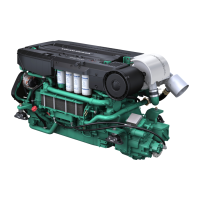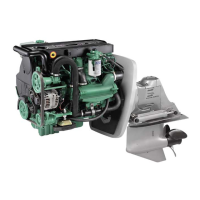Do you have a question about the Volvo Penta 13L and is the answer not in the manual?
Basic safety rules for engine operation, handling chemicals, and wearing PPE.
Safety guidelines for eye protection, skin care, fire prevention, and handling hot surfaces.
Safety protocols for electrical systems, welding, refueling, and battery handling.
Proper procedures for battery maintenance and clutch adjustments to prevent damage.
Purpose and scope of the operator's manual, including warranty information.
Guidance on running-in, fuel, oil, coolant usage, and maintenance schedules.
Details on environmental care, certified engines, EATS, dealer network, and action service.
Description of the TAD engine series, including their features and emission control systems.
Explanation of the EMS, its functions, and diagnostic capabilities for engine control.
Details on the EATS, AdBlue®/DEF, and system monitoring for emission reduction.
Information on the AdBlue®/DEF tank, its components, heating, storage, and operation.
Introduction to the DCU control panel and its functionalities for engine monitoring and control.
Explains the DCU II and DU instrument panels, their displays, and status indicators.
Covers navigation of menus, display settings, language options, and data logging.
Describes the CIU as a translator and lists available Easy Link instruments.
Essential pre-start inspection of oil level, fuel valves, coolant, and leaks.
Step-by-step guide for starting the engine with and without pre-heating.
Preparations and recommendations for starting the engine in very cold weather conditions.
Warnings against start spray and procedures for using auxiliary batteries for starting.
Instructions for checking engine instruments and responding to system alarms.
Guidance on proper engine operation, avoiding prolonged low load and idle.
Steps for before, during, and after engine shutdown to ensure proper operation and longevity.
Actions to take after shutting down the engine, including checks for leaks and maintenance.
Explanation of the diagnostic system, fault detection, and fault code interpretation.
How faults are displayed on DCU/DU panels and how to interpret warnings and messages.
Guidance on troubleshooting symptoms and understanding EATS warning symbols.
Explains EATS system responses to low tank levels, quality issues, and component faults.
Comprehensive list of fault codes (SPN, FMI) for the EATS system and engine.
Outlines various service intervals (S1, S2, S3, Type A-D) based on operating hours or time.
Procedures for performing a visual inspection of the engine and its components.
Steps for checking and replacing the engine's air filter.
Inspecting charge air hoses and drive belts for wear and tension.
Procedures for changing the drive belt and alternator belt.
Maintenance for oil level, oil changes, and oil filter replacement.
Tasks for draining fuel, replacing filters, and bleeding the fuel system.
Guidelines for coolant levels, mixing, draining, and system cleaning.
Procedures for filling AdBlue®/DEF and changing the DEF pump filter.
Maintenance of the electrical system, main switch, fuses, and batteries.
Steps for conserving the engine for long-term storage and bringing it back into service.
Technical details for TAD engine series, including bore, stroke, displacement, and weight.
Specifications for oil capacity, pressure, filters, and fuel quality requirements.
Technical data for the cooling system, including coolant volume and thermostat specifications.
Information on locating and understanding engine identification labels and numbers.
Declaration of conformity for partially completed machinery according to EU directives.
Basic safety rules for engine operation, handling chemicals, and wearing PPE.
Safety guidelines for eye protection, skin care, fire prevention, and handling hot surfaces.
Safety protocols for electrical systems, welding, refueling, and battery handling.
Proper procedures for battery maintenance and clutch adjustments to prevent damage.
Purpose and scope of the operator's manual, including warranty information.
Guidance on running-in, fuel, oil, coolant usage, and maintenance schedules.
Details on environmental care, certified engines, EATS, dealer network, and action service.
Description of the TAD engine series, including their features and emission control systems.
Explanation of the EMS, its functions, and diagnostic capabilities for engine control.
Details on the EATS, AdBlue®/DEF, and system monitoring for emission reduction.
Information on the AdBlue®/DEF tank, its components, heating, storage, and operation.
Introduction to the DCU control panel and its functionalities for engine monitoring and control.
Explains the DCU II and DU instrument panels, their displays, and status indicators.
Covers navigation of menus, display settings, language options, and data logging.
Describes the CIU as a translator and lists available Easy Link instruments.
Essential pre-start inspection of oil level, fuel valves, coolant, and leaks.
Step-by-step guide for starting the engine with and without pre-heating.
Preparations and recommendations for starting the engine in very cold weather conditions.
Warnings against start spray and procedures for using auxiliary batteries for starting.
Instructions for checking engine instruments and responding to system alarms.
Guidance on proper engine operation, avoiding prolonged low load and idle.
Steps for before, during, and after engine shutdown to ensure proper operation and longevity.
Actions to take after shutting down the engine, including checks for leaks and maintenance.
Explanation of the diagnostic system, fault detection, and fault code interpretation.
How faults are displayed on DCU/DU panels and how to interpret warnings and messages.
Guidance on troubleshooting symptoms and understanding EATS warning symbols.
Explains EATS system responses to low tank levels, quality issues, and component faults.
Comprehensive list of fault codes (SPN, FMI) for the EATS system and engine.
Outlines various service intervals (S1, S2, S3, Type A-D) based on operating hours or time.
Procedures for performing a visual inspection of the engine and its components.
Steps for checking and replacing the engine's air filter.
Inspecting charge air hoses and drive belts for wear and tension.
Procedures for changing the drive belt and alternator belt.
Maintenance for oil level, oil changes, and oil filter replacement.
Tasks for draining fuel, replacing filters, and bleeding the fuel system.
Guidelines for coolant levels, mixing, draining, and system cleaning.
Procedures for filling AdBlue®/DEF and changing the DEF pump filter.
Maintenance of the electrical system, main switch, fuses, and batteries.
Steps for conserving the engine for long-term storage and bringing it back into service.
Technical details for TAD engine series, including bore, stroke, displacement, and weight.
Specifications for oil capacity, pressure, filters, and fuel quality requirements.
Technical data for the cooling system, including coolant volume and thermostat specifications.
Information on locating and understanding engine identification labels and numbers.
Declaration of conformity for partially completed machinery according to EU directives.
| Engine Type | Diesel |
|---|---|
| Inboard | Yes |
| Number of Cylinders | 6 |
| Configuration | Inline |
| Fuel Type | Diesel |
| Fuel System | Common Rail |
| Aspiration | Turbocharged and Aftercooled |
| Emissions Compliance | IMO Tier III |
| Max Power Output | 405-735 kW (550-1000 hp) |











